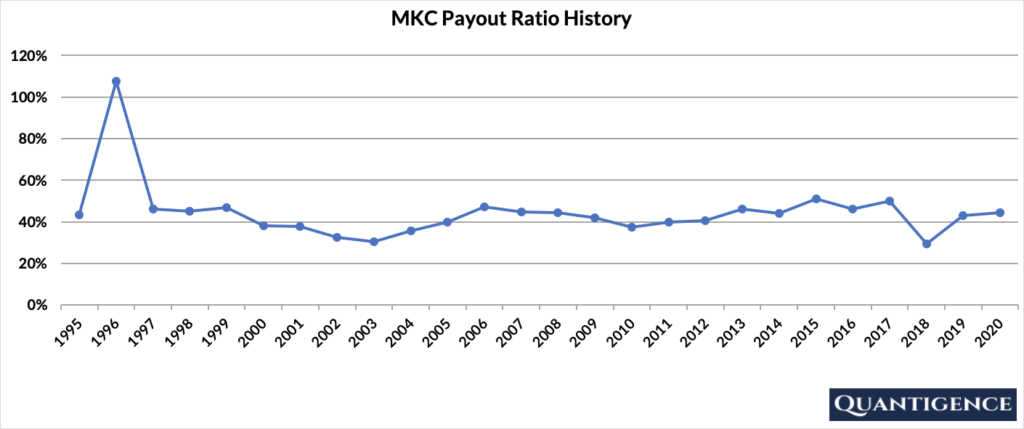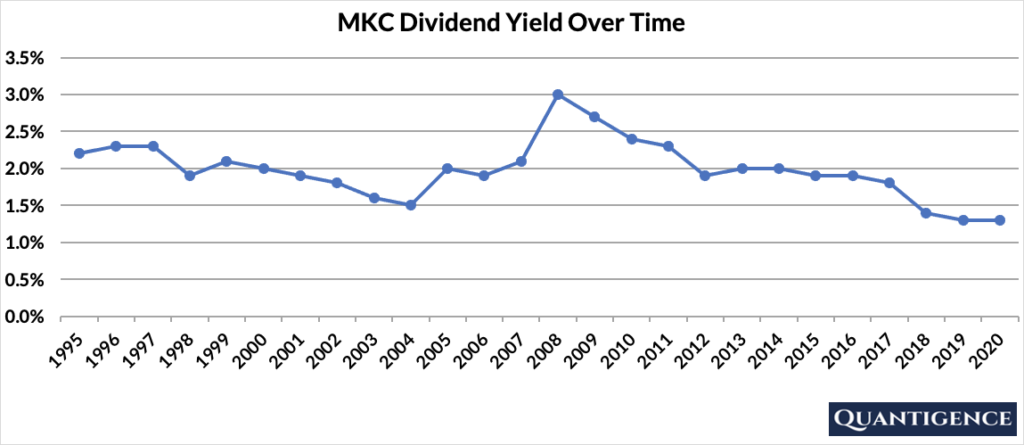McCormick & Company (NYSE: MKC) sells spices, seasoning mixes, condiments, and other flavorful products to the food industry. The company operates in two segments, Consumer and Flavor Solutions. The Consumer segment offers rice, spices, herbs, and seasonings, as well as desserts. The Flavor Solutions segment offers seasoning blends, spices and herbs, condiments, coating systems, and compound flavors to multinational food manufacturers and foodservice customers.
| Segment | 2020 Revenue (in billion USD) | Revenue % |
| Consumer | 3.60 | 64% |
| Flavor Solutions | 2.01 | 36% |
MKC’s revenues are somewhat diversified geographically with 32% of sales coming from outside the U.S.
MKC’s Dividend History and Payout Ratio
MKC has a track record of paying and increasing dividends for 34 consecutive years, a record that the company will likely feel highly obligated to maintain. In 2020, the company paid out only 44% of its profits in the form of dividends. This low payout ratio enables the company to keep growing its dividend in the future, even if earnings are not growing or temporarily declining.
In looking at the company’s payout ratio history over the past 25 years, it’s been remarkably stable. The only exception was the year 1996, when MKC underwent a strategic restructuring and increased advertising and marketing spend in order to resuscitate growth (successfully, as it later turned out).

When Does MKC Pay Dividends?
MKC pays a quarterly dividend typically announced around the end of March, June, September, and November. The ex-dates are in the following months, and payments are made close to the end of April, July, October, and January.
What is MKC’s Dividend Yield?
Dividend yield (the annual dividend paid divided by the share price) shows the 1-year income for a stock from dividends. In 2020, MKC had a dividend yield of 1.3%, below our investment universe average of 1.8%. The stock’s historical yield has been moving between 1.3% and 3.0% with an average of 2.0%.

MKC’s Dividend Growth Rate
MKC has grown its dividend payout by an average of 9.1% every year for the past 10 years, and 9.2% over the last five years, demonstrating stable high growth that well outpaces inflation. Below you can see the effect a 10-year growth rate of 9.1% has on MKC’s dividend assuming a starting yield of 1.3%.
| Years | Dividend Growth | Yield Calculation | Yield % |
| Year 0 | 0% | 1.30% | 1.3% |
| Year 1 | 9.10% | 1.3%*1.091 | 1.42% |
| Year 2 | 9.10% | 1.3%*(1.091)^2 | 1.55% |
| Year 3 | 9.10% | 1.3%*(1.091)^3 | 1.69% |
| Year 4 | 9.10% | 1.3%*(1.091)^4 | 1.84% |
| Year 5 | 9.10% | 1.3%*(1.091)^3 | 2.01% |
| Year 6 | 9.10% | 1.3%*(1.091)^6 | 2.19% |
| Year 7 | 9.10% | 1.3%*(1.091)^7 | 2.39% |
| Year 8 | 9.10% | 1.3%*(1.091)^8 | 2.61% |
| Year 9 | 9.10% | 1.3%*(1.091)^9 | 2.85% |
| Year 10 | 9.10% | 1.3%*(1.091)^10 | 3.11% |
If you bought MKC at a yield of 1.3%, an average 10-year dividend growth of 9.1% would mean your yield would be 3.11% 10 years from now. This is called “yield on cost,” and shows the yield you’re receiving on the original amount of money you invested.
How Strong is MKC’s Dividend?
When evaluating dividend stocks, we use our own methodology which is based on Q-scores which consist of seven factors:
- Years paying and increasing dividends
- Market cap
- International sales
- Yield
- Payout ratio
- Five-year dividend growth rate
- Ten-year dividend growth rate
We calculate each of these factors and summarize them in a final proprietary Q-score. To learn more about how we calculate Q-scores, check out our piece on “7 Factors Used to Select Dividend Growth Stocks.”
The Q-score for McCormick & Company is presently 12.3, which places the company in 11th position out of 14 dividend champions in the consumer staples sector. We reward MKC for its low payout ratio, its dividend growth rates, and its decent international sales. We penalize MKC for its low yield. MKC’s size and dividend growth track record contribute small amounts to its final Q-score. With many alternatives and some heavy hitters in the same sector, we do not include MKC in our final 30-stock dividend growth portfolio.
[optin-monster slug=”ziwrnabndtepsyq0fyai”]


